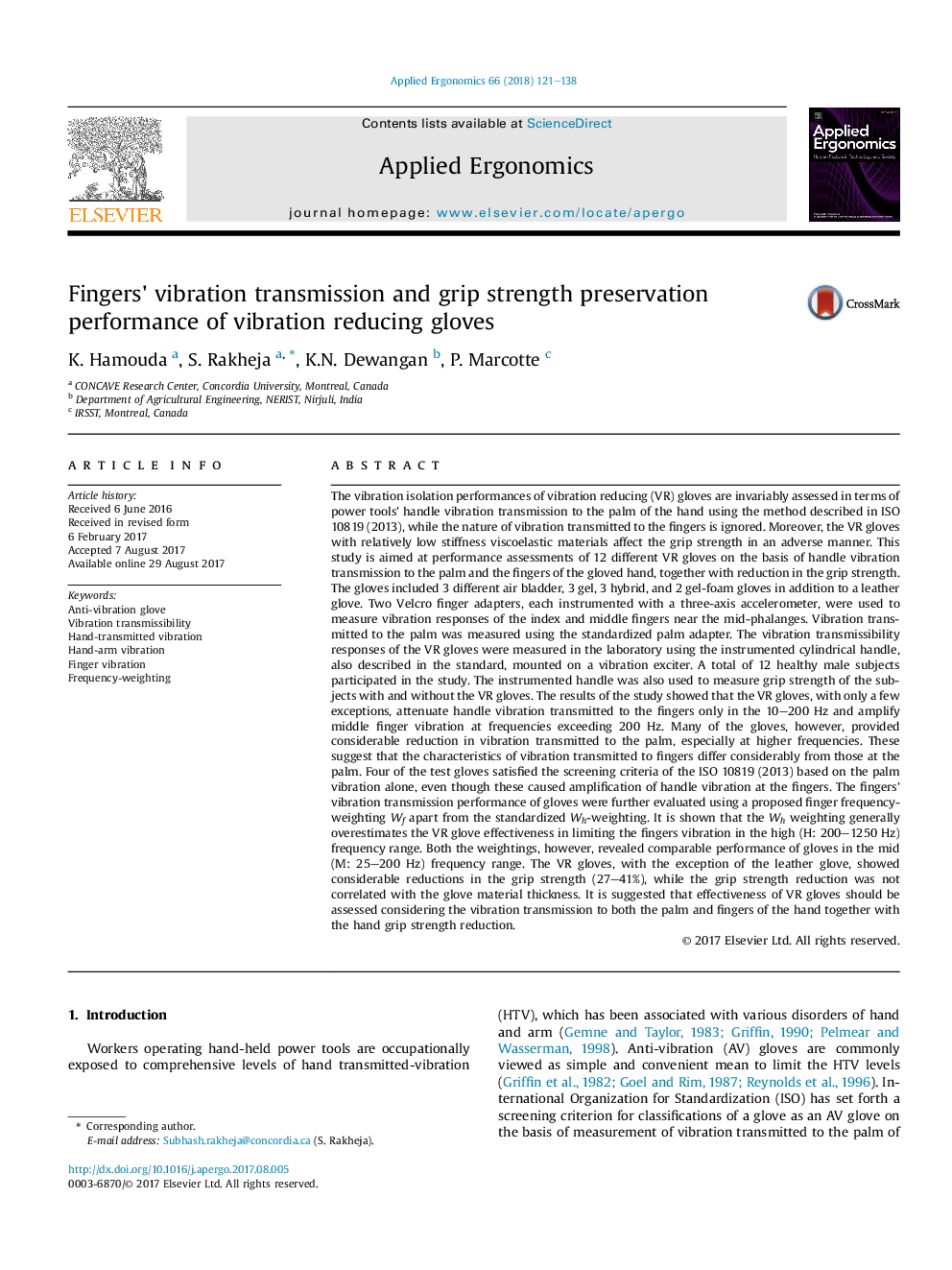| کد مقاله | کد نشریه | سال انتشار | مقاله انگلیسی | نسخه تمام متن |
|---|---|---|---|---|
| 4972003 | 1450704 | 2018 | 18 صفحه PDF | دانلود رایگان |
- Vibration transmissibility of 12 different VR gloves was measured at palm, index, and middle fingers.
- Substantial difference was found between the palm and fingers vibration responses.
- Standardized Wh-weighting generally overestimates glove effectiveness in the high frequency range as compared with Wf-weighting.
- Performance of Wh-and Wf-weighting were comparable in the mid frequency range.
- Gloves, with the exception of the leather glove, showed considerable reductions in the grip strength.
The vibration isolation performances of vibration reducing (VR) gloves are invariably assessed in terms of power tools' handle vibration transmission to the palm of the hand using the method described in ISO 10819 (2013), while the nature of vibration transmitted to the fingers is ignored. Moreover, the VR gloves with relatively low stiffness viscoelastic materials affect the grip strength in an adverse manner. This study is aimed at performance assessments of 12 different VR gloves on the basis of handle vibration transmission to the palm and the fingers of the gloved hand, together with reduction in the grip strength. The gloves included 3 different air bladder, 3 gel, 3 hybrid, and 2 gel-foam gloves in addition to a leather glove. Two Velcro finger adapters, each instrumented with a three-axis accelerometer, were used to measure vibration responses of the index and middle fingers near the mid-phalanges. Vibration transmitted to the palm was measured using the standardized palm adapter. The vibration transmissibility responses of the VR gloves were measured in the laboratory using the instrumented cylindrical handle, also described in the standard, mounted on a vibration exciter. A total of 12 healthy male subjects participated in the study. The instrumented handle was also used to measure grip strength of the subjects with and without the VR gloves. The results of the study showed that the VR gloves, with only a few exceptions, attenuate handle vibration transmitted to the fingers only in the 10-200Â Hz and amplify middle finger vibration at frequencies exceeding 200Â Hz. Many of the gloves, however, provided considerable reduction in vibration transmitted to the palm, especially at higher frequencies. These suggest that the characteristics of vibration transmitted to fingers differ considerably from those at the palm. Four of the test gloves satisfied the screening criteria of the ISO 10819 (2013) based on the palm vibration alone, even though these caused amplification of handle vibration at the fingers. The fingers' vibration transmission performance of gloves were further evaluated using a proposed finger frequency-weighting Wf apart from the standardized Wh-weighting. It is shown that the Wh weighting generally overestimates the VR glove effectiveness in limiting the fingers vibration in the high (H: 200-1250Â Hz) frequency range. Both the weightings, however, revealed comparable performance of gloves in the mid (M: 25-200Â Hz) frequency range. The VR gloves, with the exception of the leather glove, showed considerable reductions in the grip strength (27-41%), while the grip strength reduction was not correlated with the glove material thickness. It is suggested that effectiveness of VR gloves should be assessed considering the vibration transmission to both the palm and fingers of the hand together with the hand grip strength reduction.
Journal: Applied Ergonomics - Volume 66, January 2018, Pages 121-138
